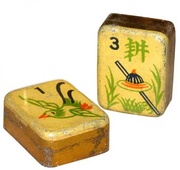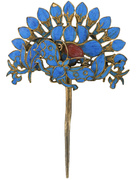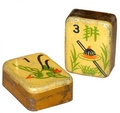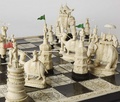If you collect or admire Indian art and antiques, you owe it to yourself to see “Maharaja: The Splendor of India’s Royal Courts,” now through April 8, 2012, at the Asian Art Museum in San Francisco. Organized by the Victoria and Albert Museum in London, the almost 200-piece exhibition features fashions and furniture, paintings and fine jewelry, and plenty of weaponry, from flintlocks used by carefree kings on hunting excursions to the daggers and swords carried by their somber guards.
Beyond the objects, which are uniformly stunning, the show does a terrific job of bringing viewers up to speed on the complex political history of India before the East India Company solidified its hold on the subcontinent in 1858 and turned the nation into the “crown jewel” of the British colonies. In the hands of the museum’s curators, this history lesson is anything but dull. We learn, for example, how one major catalyst for Britain’s ascendancy was the decline of the Mughal Empire at the beginning of the 18th century. That led to the rise of numerous smaller, easy-to-conquer kingdoms across India, many of whose histories and riches are featured in “Maharaja.”
The reason why the show’s historical timeline is so engaging is because it’s fleshed out by the pieces on view, which are often jaw-dropping, especially the jewelry. Examples of personal adornment range from elaborate hair and ear ornaments (we’re talking a whole lot more than mere earrings, here) to the Patiala necklace, the largest necklace ever commissioned from Cartier. Though eventually cherry-picked for some of its most-prized stones, including a 234.69-carat DeBeers diamond, the Patiala necklace is still a marvel to behold, as most of its original 2,930 diamonds are still in their settings. Some of the sapphires and diamonds in other pieces are similarly breathtaking (the maharajas collected for quantity and size), while rubies are sprinkled on turbans and jade pots like so much confetti.
While the early maharajas are presented as spiritual warriors, they appear to have had plenty of time for leisure activities. An early 19th-century flintlock decorated with gold and enamel is one of the most exotic guns I’ve seen (one can easily imagine the Sand People in Star Wars carrying these things), while the games box made of an Indian rosewood called shisham (see image at top), from roughly the same period, is inlaid with ivory and brass because, well, it could be. You might not be able to collect like the maharajas, but this window on their world is the next best thing.
For another take on “Maharaja,” read the review I wrote for kqed.org.






 The Art of War: Exquisite Chess Sets Once Captured the Game's Global Heritage
The Art of War: Exquisite Chess Sets Once Captured the Game's Global Heritage
 Antique Mahjong Sets: An Antidote to Our Antisocial Internet Society
Antique Mahjong Sets: An Antidote to Our Antisocial Internet Society The Art of War: Exquisite Chess Sets Once Captured the Game's Global Heritage
The Art of War: Exquisite Chess Sets Once Captured the Game's Global Heritage Unraveling the Ancient Riddles of Chinese Jewelry
Unraveling the Ancient Riddles of Chinese Jewelry Indian AntiquesDecorative antiques from India are as varied as the people who’ve called th…
Indian AntiquesDecorative antiques from India are as varied as the people who’ve called th… Mari Tepper: Laying it on the Line
Mari Tepper: Laying it on the Line Nice Ice: Valerie Hammond on the Genteel Charm of Vintage Canadian Costume Jewelry
Nice Ice: Valerie Hammond on the Genteel Charm of Vintage Canadian Costume Jewelry How Jim Heimann Got Crazy for California Architecture
How Jim Heimann Got Crazy for California Architecture Modernist Man: Jock Peters May Be the Most Influential Architect You've Never Heard Of
Modernist Man: Jock Peters May Be the Most Influential Architect You've Never Heard Of Meet Cute: Were Kokeshi Dolls the Models for Hello Kitty, Pokemon, and Be@rbrick?
Meet Cute: Were Kokeshi Dolls the Models for Hello Kitty, Pokemon, and Be@rbrick? When the King of Comedy Posters Set His Surreal Sights on the World of Rock 'n' Roll
When the King of Comedy Posters Set His Surreal Sights on the World of Rock 'n' Roll How One Artist Makes New Art From Old Coloring Books and Found Photos
How One Artist Makes New Art From Old Coloring Books and Found Photos Say Cheese! How Bad Photography Has Changed Our Definition of Good Pictures
Say Cheese! How Bad Photography Has Changed Our Definition of Good Pictures Middle Earthenware: One Family's Quest to Reclaim Its Place in British Pottery History
Middle Earthenware: One Family's Quest to Reclaim Its Place in British Pottery History Fancy Fowl: How an Evil Sea Captain and a Beloved Queen Made the World Crave KFC
Fancy Fowl: How an Evil Sea Captain and a Beloved Queen Made the World Crave KFC
Leave a Comment or Ask a Question
If you want to identify an item, try posting it in our Show & Tell gallery.